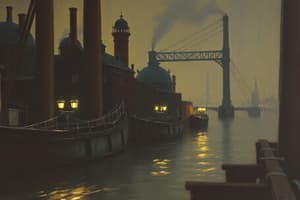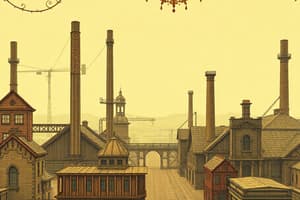Podcast
Questions and Answers
What time period does the Gilded Age refer to?
What time period does the Gilded Age refer to?
- 1870s - 1890s (correct)
- 1860s - 1870s
- 1920s - 1930s
- 1900s - 1920s
What was the focus of the Technological Revolution?
What was the focus of the Technological Revolution?
Based on steel, railroads, electricity, and oil-based products.
Who is Alexander Graham Bell?
Who is Alexander Graham Bell?
An American inventor known for developing the telephone.
What is Thomas Edison best known for?
What is Thomas Edison best known for?
What is a Telephone?
What is a Telephone?
What is the Free Enterprise System?
What is the Free Enterprise System?
What does Laissez-Faire mean?
What does Laissez-Faire mean?
What defines a Corporation?
What defines a Corporation?
What is the Bessemer Process?
What is the Bessemer Process?
What does Entrepreneurship involve?
What does Entrepreneurship involve?
What is a Monopoly?
What is a Monopoly?
Who was Andrew Carnegie?
Who was Andrew Carnegie?
Who is John Rockefeller?
Who is John Rockefeller?
What is a Robber Baron?
What is a Robber Baron?
What is a Captain of Industry?
What is a Captain of Industry?
What does Philanthropy mean?
What does Philanthropy mean?
What are Political Machines?
What are Political Machines?
What is Immigration?
What is Immigration?
What are Push and Pull Factors?
What are Push and Pull Factors?
Who are Nativists?
Who are Nativists?
What are Ethnic Ghettos?
What are Ethnic Ghettos?
What is Child Labor?
What is Child Labor?
What is a Labor Union?
What is a Labor Union?
What are Strikes?
What are Strikes?
What was the Knights of Labor?
What was the Knights of Labor?
What happened during the Haymarket Massacre?
What happened during the Haymarket Massacre?
What is the AFL?
What is the AFL?
Who was Samuel Gompers?
Who was Samuel Gompers?
What is the IWW?
What is the IWW?
What is Manifest Destiny?
What is Manifest Destiny?
What does Westward Migration refer to?
What does Westward Migration refer to?
What was the Homestead Act?
What was the Homestead Act?
What was the Transcontinental Railroad?
What was the Transcontinental Railroad?
What are the Great Plains?
What are the Great Plains?
What is meant by Frontier?
What is meant by Frontier?
What was the Klondike Gold Rush?
What was the Klondike Gold Rush?
What were the Indian Wars?
What were the Indian Wars?
What are Reservations?
What are Reservations?
What was the Dawes Act?
What was the Dawes Act?
What is New Immigration?
What is New Immigration?
What is Ellis Island?
What is Ellis Island?
Who was Boss Tweed?
Who was Boss Tweed?
What is a Tenement?
What is a Tenement?
What was the Pendleton Civil Service Act?
What was the Pendleton Civil Service Act?
What is the Chinese Exclusion Act?
What is the Chinese Exclusion Act?
What was the Progressive Era?
What was the Progressive Era?
Who was William Jennings Bryan?
Who was William Jennings Bryan?
What are Populists?
What are Populists?
What are Farm Issues?
What are Farm Issues?
What does Social Gospel refer to?
What does Social Gospel refer to?
What is Americanization?
What is Americanization?
What is Assimilation?
What is Assimilation?
Who was Jacob Riis?
Who was Jacob Riis?
Who was Jane Addams?
Who was Jane Addams?
Who was Frances Willard?
Who was Frances Willard?
What was Alfred T. Mahan's contribution?
What was Alfred T. Mahan's contribution?
Who was Sanford B. Dole?
Who was Sanford B. Dole?
Who was Henry Cabot Lodge?
Who was Henry Cabot Lodge?
Who was Theodore Roosevelt?
Who was Theodore Roosevelt?
What is Yellow Journalism?
What is Yellow Journalism?
What year did the Spanish-American War occur?
What year did the Spanish-American War occur?
What were the causes of the Spanish-American War?
What were the causes of the Spanish-American War?
What was the result of the Spanish-American War?
What was the result of the Spanish-American War?
What was the Open Door Policy?
What was the Open Door Policy?
What is Imperialism?
What is Imperialism?
What is the Panama Canal?
What is the Panama Canal?
What is Dollar Diplomacy?
What is Dollar Diplomacy?
What was the Sherman Anti-Trust Act?
What was the Sherman Anti-Trust Act?
What is the Interstate Commerce Act?
What is the Interstate Commerce Act?
What is the Progressive Party?
What is the Progressive Party?
What do Initiative, Referendum, and Recall represent?
What do Initiative, Referendum, and Recall represent?
Who was Upton Sinclair?
Who was Upton Sinclair?
What is the National Forest Service?
What is the National Forest Service?
What was the Pure Food and Drug Act?
What was the Pure Food and Drug Act?
What is the Federal Reserve Act?
What is the Federal Reserve Act?
What does the 16th Amendment deal with?
What does the 16th Amendment deal with?
What is the 17th Amendment about?
What is the 17th Amendment about?
What does the 18th Amendment prohibit?
What does the 18th Amendment prohibit?
What does the 19th Amendment grant?
What does the 19th Amendment grant?
Who was Susan B. Anthony?
Who was Susan B. Anthony?
What was Plessy vs. Ferguson?
What was Plessy vs. Ferguson?
Who was W.E.B. Du Bois?
Who was W.E.B. Du Bois?
Who was Ida B. Wells?
Who was Ida B. Wells?
What were the causes of WWI?
What were the causes of WWI?
What years did WWI take place?
What years did WWI take place?
What led to the U.S. entry into WWI?
What led to the U.S. entry into WWI?
What was the Selective Service Act?
What was the Selective Service Act?
What is Trench Warfare?
What is Trench Warfare?
Who was General John J. Pershing?
Who was General John J. Pershing?
What was the Battle of Argonne Forest?
What was the Battle of Argonne Forest?
Who was Alvin York?
Who was Alvin York?
What technological advancements were used in WWI?
What technological advancements were used in WWI?
What are the Fourteen Points?
What are the Fourteen Points?
What was the Treaty of Versailles?
What was the Treaty of Versailles?
What was the League of Nations?
What was the League of Nations?
What was the Great Migration?
What was the Great Migration?
What is Propaganda?
What is Propaganda?
What is the Sedition Act?
What is the Sedition Act?
Flashcards are hidden until you start studying
Study Notes
Gilded Age
- Period from the 1870s to 1890s, characterized by apparent prosperity overshadowing political corruption and social inequality.
Technological Revolution
- During the Second Industrial Revolution, innovations in steel production, railroad expansion, electricity, and oil were prominent.
Key Inventors
- Alexander Graham Bell invented the telephone, revolutionizing communication.
- Thomas Edison created the electric light bulb, acoustic recording on wax cylinders, and developed motion pictures.
Economic Concepts
- Free Enterprise System allows minimal government involvement in business operations.
- Laissez-Faire promotes non-interventionist economic policies.
- Corporations, owned by multiple investors, became prevalent during this period.
Industrial Advancements
- The Bessemer Process enabled efficient steel production, patented in 1856.
- Entrepreneurship involves taking risks to start and manage businesses.
Market Structures
- A monopoly is a market controlled by a single seller with many buyers.
- Andrew Carnegie dominated the steel industry through vertical integration.
- John D. Rockefeller established a monopoly with the Standard Oil Company via trust agreements.
Labor Movement
- Robber Barons exploited workers, contrasting with Captains of Industry who had positive impacts.
- Philanthropy emerged as a way for wealthy individuals to donate to the needy.
- Political machines, led by bosses, often manipulated city politics and elections.
Immigration Patterns
- Push and pull factors drove many to migrate; push factors led to departure from home, while pull factors attracted them to new locations.
- Nativists opposed immigration, fearing job losses and cultural changes.
- Ethnic ghettos developed as immigrants settled together, maintaining cultural ties.
Child Labor and Labor Unions
- Child labor was prevalent as children worked in various industries during the 19th century.
- Labor unions sought better working conditions, wages, and benefits, often resulting in strikes.
Key Labor Organizations
- The Knights of Labor aimed to unify all workers but struggled due to vague goals and organization issues.
- The AFL, founded by Samuel Gompers, focused on skilled workers and became a leading labor union.
- The IWW (Industrial Workers of the World) organized unskilled laborers and was known for its radical approach.
Westward Expansion
- Manifest Destiny justified the U.S. belief that it was destined to span the continent.
- Westward migration was spurred by opportunities like jobs, land, and gold, notably from the Homestead Act of 1862 offering free land.
- The Transcontinental Railroad, completed in 1869, connected the east and west coasts, transforming transportation.
Native American Relations
- Indian Wars (1850-1890) involved conflicts between U.S. forces and Native tribes, leading to the establishment of reservations.
- The Dawes Act of 1887 aimed to assimilate Native Americans by distributing land and promoting education.
Immigration Trends
- New Immigration saw waves of individuals from Southern and Eastern Europe and Asia in the late 1800s.
- Ellis Island served as an entry point for millions of immigrants starting in 1892.
Political Practices
- Boss Tweed led Tammany Hall, a notorious political machine in New York.
- Tenements housed many immigrant families under poor living conditions.
Progressive Reforms
- The Progressive Era focused on reforming various aspects of American society, including politics and social issues.
- Key legislation included the Pendleton Civil Service Act, which established merit-based government employment.
Women's Suffrage
- Susan B. Anthony was a key leader in the fight for women's voting rights.
- The 19th Amendment granted women the right to vote in 1920.
Civil Rights Movement
- Plessy vs. Ferguson upheld the "separate but equal" doctrine, impacting racial segregation laws.
- W.E.B. Du Bois advocated for immediate civil rights for African Americans through the NAACP.
World War I Overview
- Causes of WWI included alliances, nationalism, militarism, imperialism, and the assassination of Archduke Francis Ferdinand.
- The U.S. entered WWI due to unrestricted submarine warfare and the Zimmerman Telegram in 1917.
War Contributions and Consequences
- The Selective Service Act initiated a military draft for men aged 21-30.
- Trench warfare characterized the combat in WWI, resulting in high casualty rates and stalemates.
Key Figures and Events in WWI
- General John J. Pershing led the American Expeditionary Force.
- The Battle of Argonne Forest marked significant American involvement, resulting in heavy casualties but ultimately an Allied victory.
Post-War Reforms
- The Fourteen Points proposed by President Wilson aimed for lasting peace.
- The Treaty of Versailles imposed heavy reparations on Germany, altering the geopolitical landscape.
Aftermath and Social Changes
- The League of Nations was established to foster international cooperation but lacked real power and U.S. participation.
- The Great Migration saw over 300,000 African Americans move north, seeking better opportunities during and after the war.
Propaganda and Public Opinion
- Propaganda played a crucial role in influencing public opinion during the war.
- The Sedition Act of 1918 criminalized criticism of the government, reflecting wartime tensions.
Studying That Suits You
Use AI to generate personalized quizzes and flashcards to suit your learning preferences.




